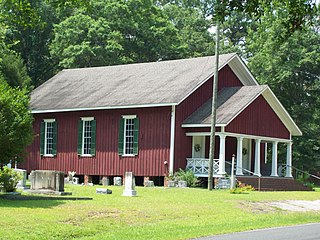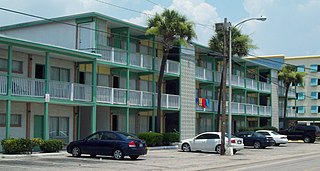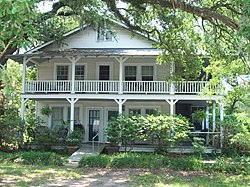
Horry County is the easternmost county in the U.S. state of South Carolina. As of the 2010 census, its population was 289,650, making it the fourth-most populous county in South Carolina. The county seat is Conway.

Myrtle Beach is a coastal city on the East Coast of the United States in Horry County, South Carolina. It is located in the center of a long and continuous 60-mile (97 km) stretch of beach known as "The Grand Strand" in northeastern South Carolina.

The Grand Strand is an arc of beach land on the Atlantic Ocean in South Carolina, United States, extending more than 60 miles (97 km) from Little River to Winyah Bay. It is located in Horry and Georgetown Counties on the NE South Carolina coast.

This is a list of the National Register of Historic Places listings in Horry County, South Carolina.

The J. Warren Smith House is a house at 21 North Palmetto Street at the corner of North Palmetto and Edgemont Streets in Liberty, South Carolina in Pickens County. It has also been called "Maggie Manor" and the Myrtle Inn, which were names during its use as a boarding house. It was named to the National Register of Historic Places on January 26, 2005. It is considered an excellent example of a Colonial Revival house and for its connection with J. Warren Smith, who was a local business executive.

Myrtle Beach Atlantic Coast Line Railroad Depot is a historic train station located at Myrtle Beach in Horry County, South Carolina. It was built in 1937 by the Atlantic Coast Line Railroad, and is one-story rectangular building was constructed with the standard ACL bi-level floor plan that has a raised freight room with steps leading down to the lobby/office area. It features exterior architectural detailing reflecting Colonial Revival, Craftsman, and Mission stylistic influences.

J. W. Holliday Jr. House is a historic home located at Conway in Horry County, South Carolina. It was built in 1910, and is a two-story, rectangular, side-gable, frame, weatherboard-clad residence. It is dominated by a pedimented Beaux-Arts style portico with giant paired Ionic order columns.

C.P. Quattlebaum House is a historic home located at Conway in Horry County, South Carolina. It was built in 1807. It is a two-story, "T"-plan, cross-gable roofed, frame, weatherboard-clad residence. It features a two-story, projecting, polygonal bay and two-tiered wrap around porch with sawn brackets. Its owner, Cephas Perry Quattlebaum, served as Conway's first mayor and his office is located nearby, the C.P. Quattlebaum Office.

Paul Quattlebaum House is a historic home in Conway, Horry County, South Carolina, It was built about 1890 and is a 1½-story, gambrel-roofed, single-clad frame residence. It was remodeled in 1911 in the Dutch Colonial Revival style by Paul Quattlebaum to take its present form.

Burroughs School, also known as Burroughs Graded School, is a historic school located at Conway in Horry County, South Carolina. It was built in three phases between 1905 and 1923. The earliest portion of the building was built as an elementary school and has three main portions of eleven bays. It features a one-story, hip roof porch supported by six Ionic order columns with Scamozzi capitals. About 1915 a two-story hipped classroom wing was added and in 1923 four classrooms and an auditorium was added to the complex.

Old Horry County Courthouse, now known as Conway City Hall, is a historic courthouse building located at Conway in Horry County, South Carolina. It was built between 1824 and 1825 and reputedly designed by Robert Mills (1781-1855). It is a two-story Classical Revival brick building. It features an extended pediment supported by Doric order columns that shelters a second story portico which does not extend the full width of the façade.

Hebron Church, also known as Hebron Methodist Church, is a historic Methodist church located at Bucksville in Horry County, South Carolina. The sanctuary was built about 1855 and is a rectangular "meeting house form" one-story frame church with batten siding and a gable roof covered with tin. It features a slightly lower, pedimented, projecting portico supported by five square, wooden columns. Also on the property are two graveyards: the church graveyard and the Henry Buck family graveyard located across the road.

Buck's Upper Mill Farm, also known as Henry Buck House, is a historic home located at Bucksville in Horry County, South Carolina. The house was built about 1838 and is a typical two-story, central hall, framed farmhouse, or "I"-House. The front façade features a full-length, one-story porch with a shed roof supported by six square posts. Also on the property are a one-story frame building constructed in the 19th century as a commissary for Buck's lumber business, and the ruins of a sawmill.

Chesterfield Inn, also known as Chesterfield Inn and Motor Lodge, was a historic hotel located at Myrtle Beach in Horry County, South Carolina. The Chesterfield Inn consisted of two three-story, rectangular buildings constructed in 1946 and 1965. The 1946 building was of frame construction with a brick veneer exterior, with an end to front gable roof, and a raised basement foundation. It was an unusual example of Colonial Revival style architecture in the Myrtle Beach area.

Rainbow Court was a historic hotel complex located at Myrtle Beach in Horry County, South Carolina. The complex of buildings ranged in dates of construction from 1935 to 1959. The complex included: two motel-type buildings, five beach cottages/boarding houses, and a small house. The buildings were situated around an open court with a swimming pool. There were six contributing buildings. It was one of the few remaining examples of the small-scale, low-rise motels that pre-dated Hurricane Hazel (1954).

Ocean Forest Country Club, also known as Ocean Forest Hotel and Country Club, is a historic country club and hotel located at Myrtle Beach in Horry County, South Carolina. The club and hotel were designed by an influential New York architect, Raymond Hood (1881-1934) and is an unusual example of Classical Revival architecture. Construction of the club began in 1926 and was completed in 1927. In addition to the hotel / club building, a 27-hole golf course was built in association with the club. It was designed by Robert White, a golf course designer and future president of the Professional Golfers' Association of America. The present 18-hole course dates to 1946.

Myrtle Heights–Oak Park Historic District is a national historic district located at Myrtle Beach in Horry County, South Carolina. It encompasses 89 contributing buildings and one contributing site. They relate to the period of residential development in Myrtle Beach following the financial collapse of Woodside Brothers, the company that developed the Ocean Forest Hotel and Country Club in the late 1920s. The Myrtle Heights section was opened in 1933 and the Oak Park Section was opened in 1935. The majority of these oceanside residences were built between about 1925 and 1945 and are two-story frame buildings, many of them with one- or two-story attached garages, two-story detached garage apartments, or one-story attached servants’ quarters. They reflect a variety of popular architectural styles, the most prevalent being Colonial Revival. Also represented are the Classical Revival, Tudor Revival, and Bungalow/Craftsman styles.
The Conway Seashore Railroad was a South Carolina railroad that operated in the early 20th century. It ran from Conway, South Carolina southeast to Myrtle Beach, South Carolina.

Horry-Guignard House is a historic home located at Columbia, South Carolina. It was built before 1813, and is a two-story, late Federal style, modified I-house type frame dwelling. The front facade features a one-story, full-width balustraded porch supported by square columns. During the winter of 1813–1814, the main hall was widened from six feet to eleven feet. To do this, the house was sawed in half and the two ends were pulled apart to rest on two new foundations. It was probably built by Peter Horry (1747-1815), a Revolutionary War Colonel and Brigadier General of the South Carolina Militia. Later, the house was acquired by John Gabriel Guignard (1751-1822), the Surveyor General of South Carolina from 1798 to 1802. Guignard is responsible for the early design of the city and laid out the first streets of Columbia.






















